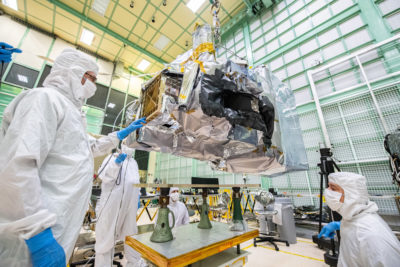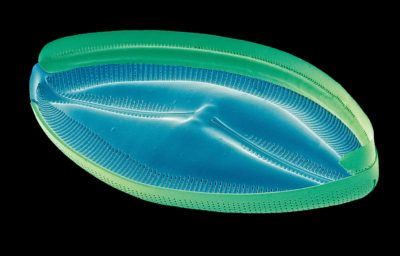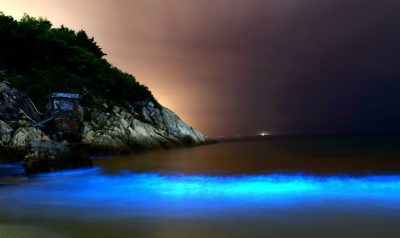Across the world’s oceans, an invisible army of tiny organisms has a supersized impact on the planet. Plankton are at the base of the ocean food chain, feeding fish that feed billions of people. They are responsible for half of the world’s oxygen supply and half of our planet’s annual carbon sink. Miniscule but powerful, their presence can help or hinder ecosystems — by soaking up greenhouse gas, for example, or by spewing toxins. Where plankton live, how many there are, when they bloom and which species dominate each play a huge role in this delicate balance. And our changing climate is spurring a sea change in all of it.
“We’re headed into an ocean and, for that matter, a world that we’re not going to recognize because it’s changing so fundamentally,” says David Hutchins, a marine microbiologist at the University of Southern California, who has charted plankton’s future.
Climate change is hitting our oceans hard, making them warmer and more acidic, while radically altering currents. The outlook for plankton is mixed. Some studies report overall plankton numbers dropping, while others show them rising in some major ocean basins. As the planet warms, the diversity of the menagerie in many spots is increasing, says Clare Ostle, a marine biogeochemist at the University of Plymouth. But certain species are losing out, she adds, including big juicy plankton thought to be important for food webs and carbon sequestration. And, in the long term, plankton numbers may plummet as climate change starves them of nutrients.
Scientists are shocked by the knowledge gaps. “I always find it surprising how little is known about plankton,” says one expert.
Scientists are now struggling to work out what the net effect will be. They have some new technologies at their disposal, including a new NASA satellite called PACE — for Plankton, Aerosol, Cloud, ocean Ecosystem — launched this February. And some old ones, including a decades-old program that painstakingly trawls the ocean with filters to scoop up tiny creatures and count them by hand. Yet scientists say they are shocked by the size of our knowledge gaps. “I always find it surprising how little is known about plankton,” says Ostle.
The Ocean Stewardship Coalition this month released a “plankton manifesto” at the United Nations General Assembly in New York, highlighting how important plankton are alongside how little we know about them. “The planetary importance of plankton remains largely ignored,” the group writes, alongside a plea for more research, education, and discussion in international treaties about plankton’s plight.
The word “plankton,” from the Greek for “wanderer,” is a catchall for the host of tiny creatures that live in fresh or salty water and drift where the currents take them. That includes plants, animals, algae, fungi, bacteria, viruses, and things that blur the lines between categories in a way that land-dwelling organisms typically don’t. There are phytoplankton that feed on sunlight and CO2, including glassy diatoms, dinoflagellates with whip-like tendrils, and spherical coccolithophores that are struggling against ocean acidification to build hard calcite shells. Others are zooplankton — tiny animals including shelled foraminifera, along with fish larvae, tiny worms, and even jellyfish. Some have a lifespan of just days; others, years.
A satellite view of a plankton bloom around the island of Svenskøya, Norway in July 2021.
NASA
Temperature has a huge impact on plankton, says Fabio Benedetti, an ecological data analyst at the University of Bern. His modelling, in agreement with other work, predicts that as waters warm, plankton will move polewards at a rate of about 21 miles per decade. “Some changes will be massive, like in the Arctic, where entire communities will be replaced by something new,” he says. Phytoplankton seem better able to cope with gradual warming than zooplankton, Benedetti says, so their habitat range and diversity looks set to increase in most regions. But that’s not necessarily good news: the most productive ocean regions, counterintuitively, have low diversity, Benedetti notes. And more diversity doesn’t necessarily mean higher numbers of plankton overall.
In the long term, researchers fear an overall decline in plankton numbers thanks to a dwindling supply of critical nutrients such as nitrogen and iron. Plankton typically rely on nutrients that have been mixed from the ocean bottom up to the surface. But melting polar ice and changing ocean currents are now increasing the density difference between top, fresh waters and deeper, saltier waters, making these layers ever-less-likely to mix. This increased “stratification,” as it is called, is expected to starve ever-more regions of the ocean. While some coastal regions are drowning in too much nitrogen, which runs off agricultural fields, much of the open ocean might become “more desert-like,” says Hutchins.
Scientists have investigated dumping massive quantities of iron into the ocean to encourage plankton to soak up CO2.
A factor working against this trend is pollution from both the burning of fossil fuels and from wildfires, which can carry nutrients far out into ocean waters. The wildly destructive Australian wildfire season of 2019-2020, for example, poured so much nutritional iron into the water that phytoplankton concentrations doubled between New Zealand and South America, creating an algae bloom bigger than Australia that lasted for months. The biggest surprise was how long the blooms lasted, says Jakob Weis at the University of Tasmania, Hobart, who studied the phenomenon. The amount of carbon soaked up by those organisms is thought to have roughly matched the carbon spewed by the fires — a helpful factor in the context of climate change. “We intentionally refrained from framing the blooms as ‘good news,’ given the devastating impact the wildfires had on the Australian public, wildlife, terrestrial ecosystems, and climate,” says Weis. But the plankton, at least, were “happy.”
Such nutrient influxes could be a big deal, says Hutchins, especially in the Southern Hemisphere where waters are particularly starved of iron. But the long-term impacts are entirely unclear. “We don’t really know if that’s going to balance out some of what’s not mixing up from below, or if it’s going to select for different communities, different species, because it’s chemically different [food],” says Hutchins. Such blooms won’t make a big dent in the big-picture fight against global warming, adds Ostle. “We’ve burned thousands of years of deposits of oil and gas. The phytoplankton blooms aren’t going to be able to cut it.”

Technicians ready an instrument for NASA’s new PACE satellite that measures ocean color.
NASA
Since the 1990s, some small-scale experiments have investigated the idea of intentionally dumping massive quantities of iron into the ocean to encourage plankton to soak up CO2. But early tests suggested that such a geoengineering scheme might not be very effective at burying carbon in the seabed for the longterm, while being expensive and difficult to carry out — not to mention the possibly huge, unknown consequences for ocean life. There have been international moratoria against large-scale commercial fertilization efforts since 2008, but research into the idea continues. Just last month, Ken Buesseler at Woods Hole Oceanographic Institution and colleagues laid out a research agenda for how to best assess this strategy’s possible risks and benefits. “You learn a lot from these experiments,” says Benedetti, “but we shouldn’t see this as a long-term solution.”
In the face of so much uncertainty, it’s vital for researchers to get on-the-ground data about how plankton are faring. The longest-running program to do this is the Continuous Plankton Recorder (CPR) Survey, an effort that has been attaching collection devices onto ocean-crossing ships since the 1930s. The technique is simple: Plankton get scooped out of surface waters and squashed onto a filter like bugs on a car windscreen. The filter rolls up as the ship moves along, creating a scroll-like record of plankton roadkill from across the ship’s track. Those filters are delivered to a lab where they are unspooled and the plankton peered at through a microscope. About a dozen workers at the University of Plymouth, the effort’s headquarters, have been trained to identify more than 600 different types of tiny creature — a task they are now trying to bolster with artificial intelligence algorithms.
In the Atlantic around Northern Europe, plankton abundances are declining by around 10 percent per decade.
The vast majority of the CPR’s data comes from the North Atlantic — a well-travelled region that happens to play an oversized role in global carbon uptake. Ostle, who heads up the CPR, says the data here shows plankton biomass increasing near the pole and decreasing closer to the tropics, as expected.
Most of the increase is, interestingly, diatoms, says Ostle — large, round phytoplankton that form juicy food balls for fish and which tend to sink quickly, making them good carbon storage bombs. “It was a surprise to see this,” says Ostle. It’s an important shift: “Diatoms are really the engines of carbon fixation,” says Hutchins, who estimates they are responsible for about half of phytoplanktons’ total carbon uptake.
Ostle suspects the explanation behind the unexpected North Atlantic diatom boom lies with sunlight. The increased ocean stratification that can stop nutrients from mixing upwards has also managed to trap diatoms in surface waters that are bathed in more light; they stay in the growing zone for longer. Eventually, says Ostle, the food disadvantage of increased stratification will likely outweigh the light advantage. But when and how remains uncertain.

A colored image of a diatom captured using an electron microscope.
Steve Gschmeissner / Science Photo Library via Alamy
The story varies from region to region. In the northeast Atlantic, around Northern Europe, plankton abundances are declining at rates of around 10 percent per decade. Some researchers have even suggested that the infamous North Sea cod crash in the 1990s, usually attributed to overfishing, was exacerbated by a plankton deficit. In the Arctic Ocean, though, plankton numbers have blossomed, with productivity increasing by more than half between 1998 and 2018, thanks not just to more open water from melting ice but also to increased nutrients, possibly introduced to the Arctic by storms and shifting currents.
There’s less data in the North Pacific and in the subtropics, but both are now starting to show an important shift away from large diatoms towards dinoflagellates, says Ostle. These smaller creatures are less nutritious; fish have to work harder to eat more of them. “That could have really big implications for the fisheries. We don’t know yet,” says Ostle.
Dinoflagellates are also the plankton responsible for bioluminescence — and, sometimes, for generating biotoxins that lead to shellfish poisoning. “We’re getting big bioluminescent blooms off of Southern California,” says Hutchins. “It’s really pretty if you go out for a walk on the beach at night and the waves are all lighting up, but they also have toxins,” he says. “I think they [dinoflagellates] are going to be one of the winners too, in in the future warmer ocean.”
It takes decades to see long-term climate change impacts in plankton, which are so variable from year to year.
Ostle has just taken on the job of chair of the Global Alliance CPR Surveys to help create a more comprehensive global picture of how plankton is faring. But it’s hard, she says. “We don’t have funding at the moment to maintain this thing, so we do it voluntarily.” While there are a dozen regional CPR surveys around the world, there are still huge swaths of the ocean where there’s no regular plankton monitoring.
Researchers can try to plug the gaps using satellites. But it takes decades to see long-term climate change impacts in plankton, which are so variable from season to season and year to year. Satellites typically measure color at the surface — a proxy for how chlorophyl-packed phytoplankton are doing.
Last year, researchers reported that data from NASA’s Aqua satellite showed that more than half of the world’s oceans have gotten greener over the past 20 years. “That was a very nonintuitive finding for a lot of the community,” says Hutchins. The implications are unclear. “A ‘greening’ doesn’t necessarily imply an increase in plankton abundance or productivity,” says B.B. Cael of the National Oceanography Centre in Southampton, who led that work. “We tried to caution against this [interpretation], but I don’t think the message got across.” Instead, Cael says, the color change might be due to shifts from one kind of plankton to another.

Bioluminescent dinoflagellates light up Dapeng Bay in Shenzen, China.
Visual China Group via Getty Images
NASA’s new satellite, PACE, launched earlier this year, should help. It can “see” in more than a hundred hues, rather than just the handful that previous satellites could spot. That should let researchers identify some specific species or groups of plankton, says Cecile Rousseaux, PACE science lead at NASA Goddard. “It tells us not just total phytoplankton, but who is in there, what type of plankton,” she says. “It’s a whole new level of information.”
Meanwhile research continues — and there’s plenty to unravel. Scientists must figure out not just which plankton species are where but also exactly when, since shifts in bloom timing can also have big knock-on effects for fisheries, says Ostle. And, she adds, the viruses that attack plankton seem to be on the rise as waters warm — another factor with as-yet unknown consequences.
Thankfully, says Hutchins, plankton have proven to be pretty robust and adaptable over billions of years of Earth’s history — so the oceanic food chain will persist in one form or another. “I don’t think we’re going to drive ocean life to extinction,” he says. “But there’s going to be different dominant species — and maybe they’re not going to be the ones we wish were there.”






